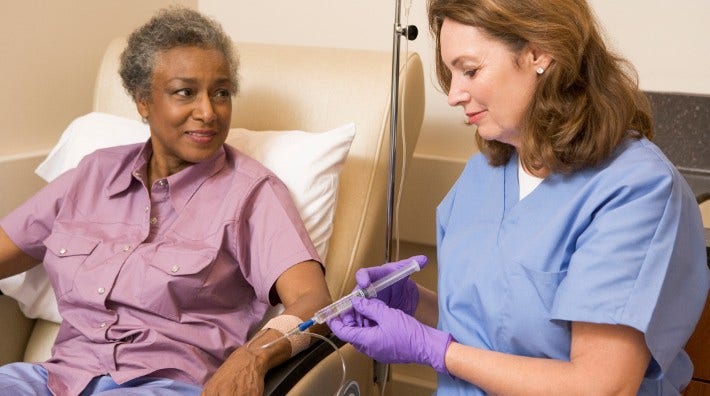Study: Lack of Insurance Linked to Higher Breast Cancer Death Rates in Black Women

Differences in health insurance are a main reason why black women are more likely to die from breast cancer, according to a new study from researchers at the American Cancer Society, Emory University in Atlanta, and Dana-Farber Cancer Institute in Boston.
Previous research has shown that since the early 1980s, black women have been more likely to die from breast cancer than white women. Data from 2015 showed a 39% higher breast cancer death rate in black women.
To find out why these differences occur, the authors of the new study analyzed data from more than 550,000 nonelderly women with breast cancer (ages 18 to 64). They studied 5 factors and found that differences in health insurance seemed to make the most significant contribution.
How the Study Was Done
Who they studied. The researchers studied 563,497 black and white women between the ages of 18 and 64 who had been diagnosed with stage I to III breast cancer.
What they studied. The researchers analyzed how several factors contributed to the differences in deaths between black and white women. They looked at differences between:
- Demographics, including age, year of diagnosis, and the state they were living in when they were diagnosed
- Comorbidities, which are other health conditions the woman had
- Health insurance, which included private insurance, no insurance, Medicare, Medicaid, and unknown
- Tumor characteristics, such as its size, stage, and whether it was hormone-receptor positive or negative, and other traits
- Treatment, which included surgery, radiation therapy, chemotherapy, and hormonal therapy
Where the data came from. The researchers used the National Cancer Data Base. It’s a nationwide hospital-based cancer registry cosponsored by the Commission on Cancer of the American College of Surgeons and the American Cancer Society. They looked specifically at the years 2004 to 2013.
Where the study is published. The findings are published in Journal of Clinical Oncology.
Differences in health insurance explained about 35% of the excess risk of death in black women compared with white women.
Most Significant Findings
Biggest impact was from health insurance coverage. Of the 5 factors studied, health insurance had the biggest influence on increased risk of death.
- Differences in health insurance explained about 35% of the excess risk of death in black women compared with white women.
- Almost 3 times as many black women were uninsured or had Medicaid insurance (22.7%) compared to white women (8.4%). The authors of the study wrote, “Lack of insurance is a barrier to receipt of timely and high-quality treatment and screening services.”
“Before 1980, there was no difference in the death rate from breast cancer between white and black women,” says Ahmedin Jemal, DVM, PhD, one of the authors of the study. “Biology hasn’t changed since then to explain this. But what has changed is advances in medicine, with discoveries of new treatments. Plus, more women are getting mammograms.” Jemal is also Vice President, Surveillance and Health Services Research for the American Cancer Society.
“Insurance provides access to standard treatments and high-quality cancer care. Insurance is also important for accessing preventive and early detection services” he adds.
Types of tumors highlighted differences in care. Differences in tumor characteristics explained about 20% of a black woman’s excess risk of death from breast cancer.
In general, the excess risk of death was higher for women who had hormone receptor-positive disease than who had hormone receptor-negative disease.
That may seem counterintuitive at first because hormone receptor-negative disease is much harder to treat. But Jemal explains, “There are more effective treatments for hormone receptor-positive breast cancer than for hormone receptor-negative cancer. When there is no (or limited) effective treatment for any woman, there is no (or less) racial disparity.”
Socioeconomic differences between black and white women may contribute to differences in treatment. Differences in whether women started treatment accounted for about 5% of a black woman’s excess risk of death from breast cancer compared to white women, after accounting for differences in insurance, comorbidity, and tumor characteristics.
The authors considered it noteworthy that the differences in treatment between black and white women were greatest for hormone therapy. Hormone therapy is often used after surgery to help reduce the chance of the breast cancer coming back. Doctors usually prescribe it for at least 5 years.
“Several studies reported that black women are less likely to complete chemotherapy and hormone therapy,” says Jemal. “This could be for many reasons, including problems with transportation or the inability to pay for medicine.”
Differences in receipt of treatment explained almost 5% of the increased risk of death for black women with hormone receptor-positive disease, and a bit less for hormone receptor-negative disease, after accounting for differences in insurance, comorbidity, and tumor characteristics.
“A number of publications have shown evidence that black women get lower quality mammograms. And, they’re less likely to have a follow-up appointment after abnormal mammograms,” Jemal says.
The Authors’ Conclusions
An important implication of the researcher’s findings, they say, is that “a substantial proportion of the excess mortality experienced by nonelderly black versus white women with breast cancer may be preventable by equalizing access to care.”
“We know so much about cancer prevention and control,” Jemal says, “but we’re not applying it to the whole population equally. We have to make the standard of care available to everyone, including people with low income. And blacks are disproportionately represented in that group.”
American Cancer Society Chief Medical Officer, Otis Brawley, MD, says the findings highlight issues related to access to care. “The importance of this, and other papers like it, is to show that access to care is a critical issue—access to care before one gets sick and access to care once one is sick. When people with cancer don’t get adequate care, they die.”
How Women Can Protect Themselves From Breast Cancer
“Whether you’re black or white, the messages are the same for everybody,” says Brawley. “I think we should be aware that uninsured women and minority women very frequently don’t talk as much to their doctors to learn about breast cancer. And there’s good data that people who have good lines of communication with their healthcare providers receive a better quality of care.”
Here are some helpful articles and resources, whether you want to lower your risk of developing breast cancer, get quality care if you have breast cancer, or take care to prevent a return of breast cancer after treatment. Reading them may help you feel more confident about talking with your doctor.
How Can I Lower My Risk of Breast Cancer?
- Citation
- For researchers
Factors That Contributed to Black-White Disparities in Survival Among Nonelderly Women With Breast Cancer Between 2004 and 2013. Published October 16, 2017 in Journal of Clinical Oncology.
American Cancer Society news stories are copyrighted material and are not intended to be used as press releases. For reprint requests, please see our Content Usage Policy.




